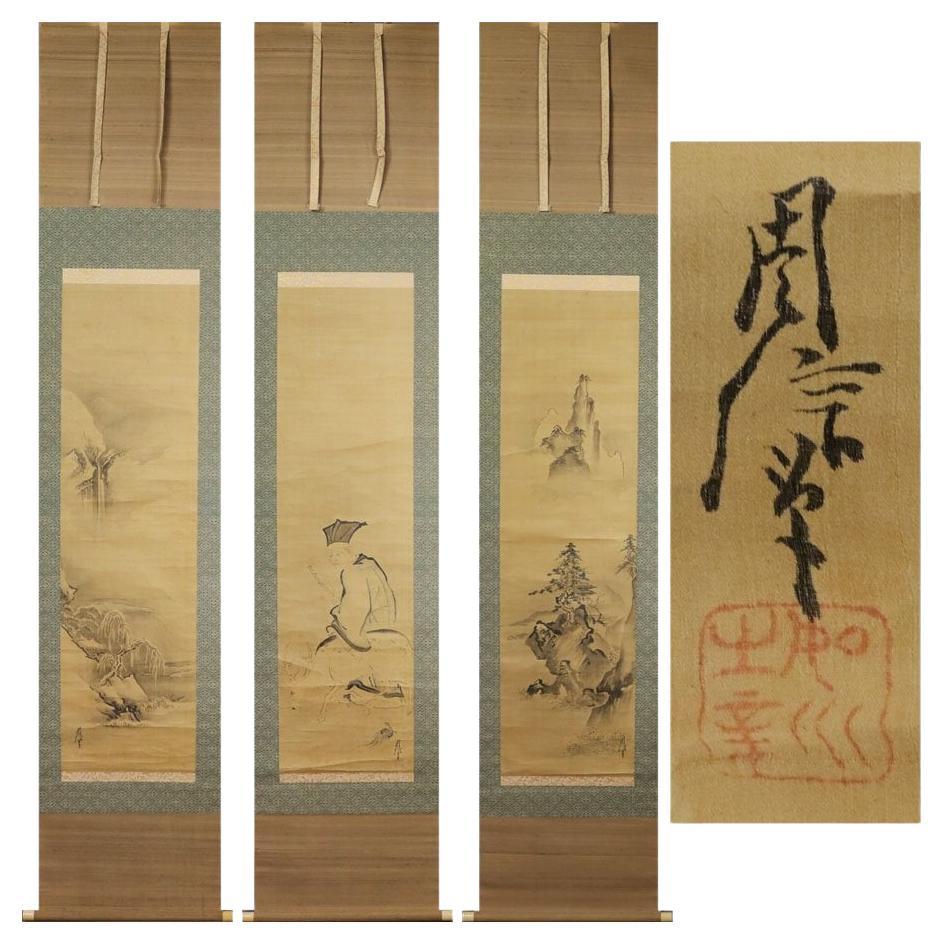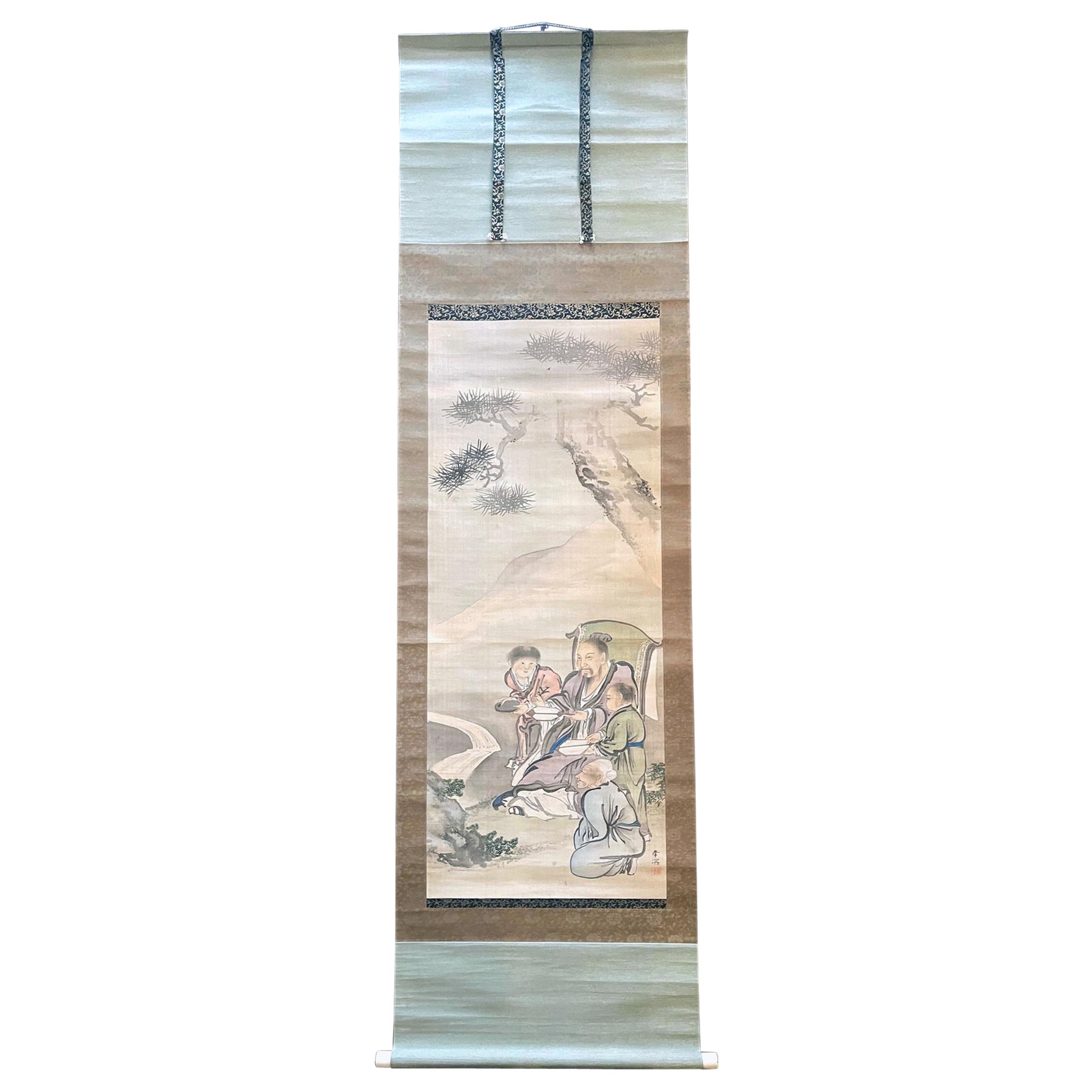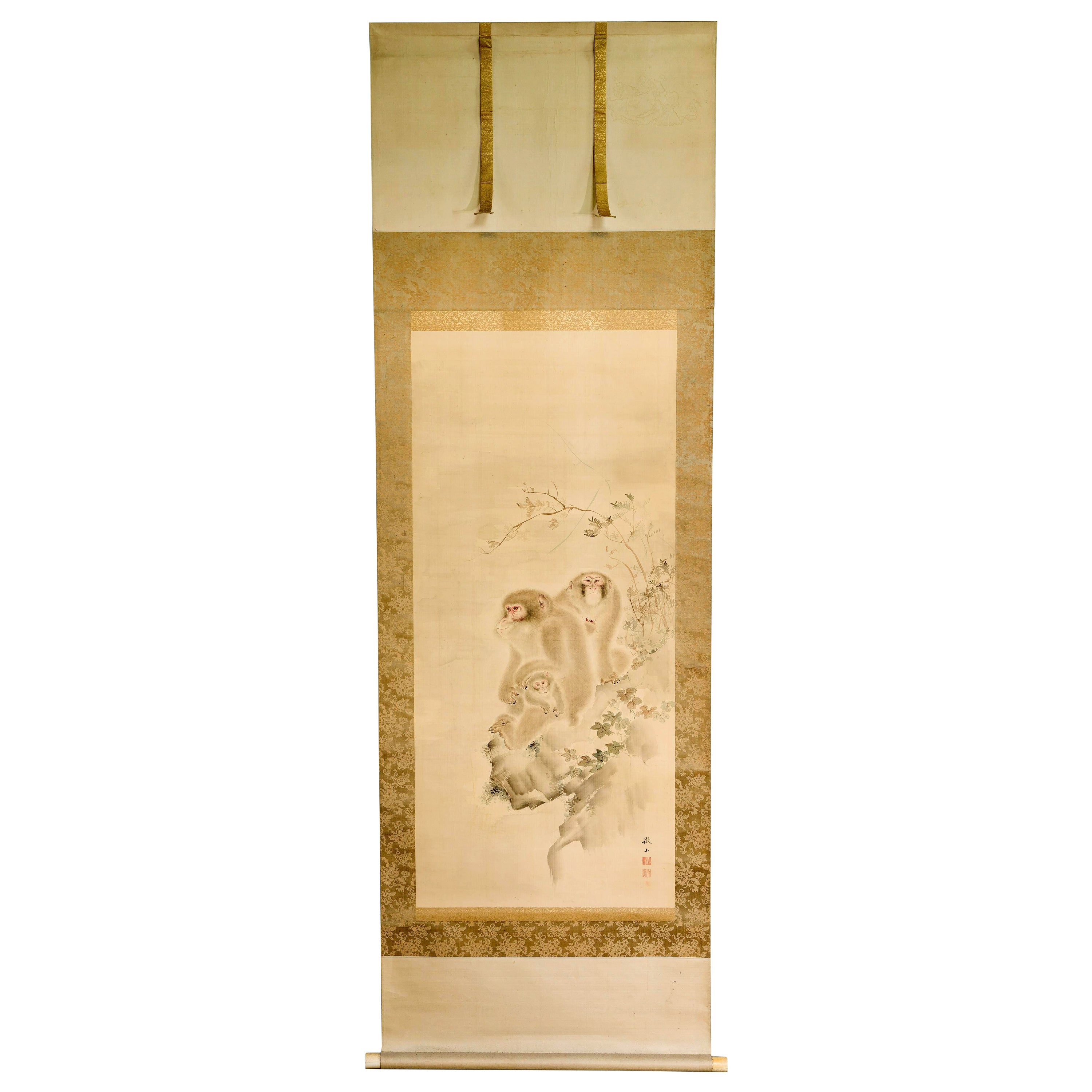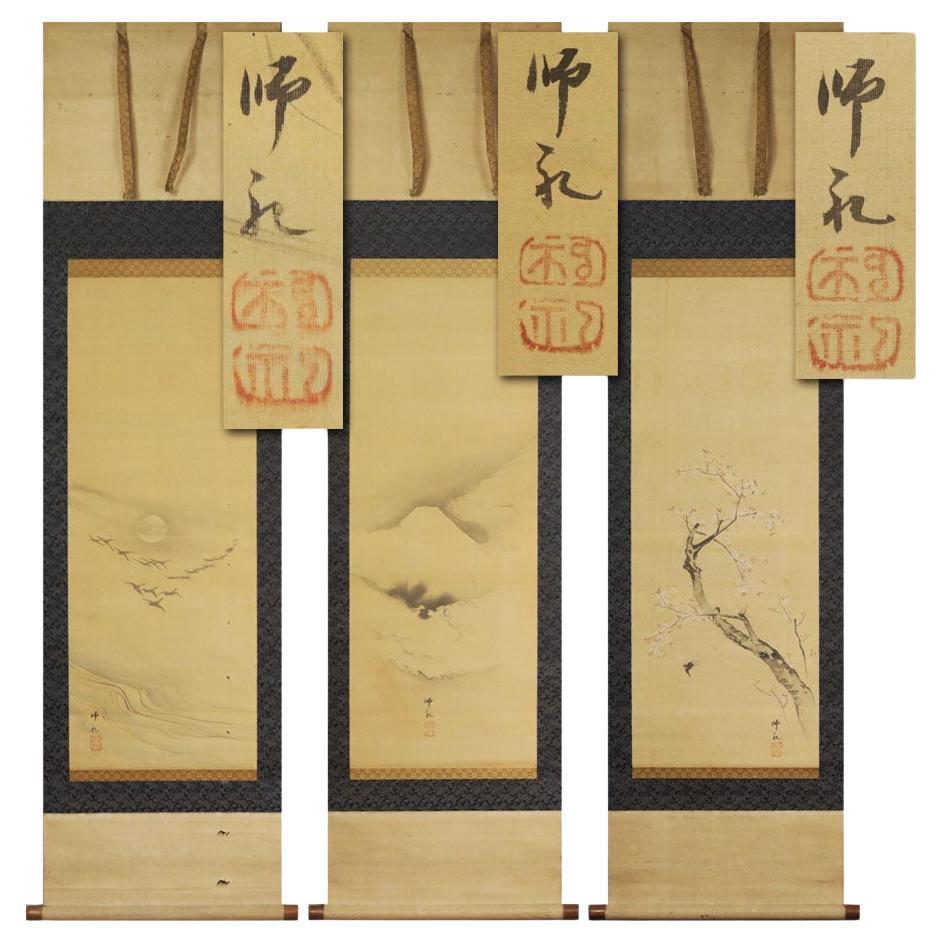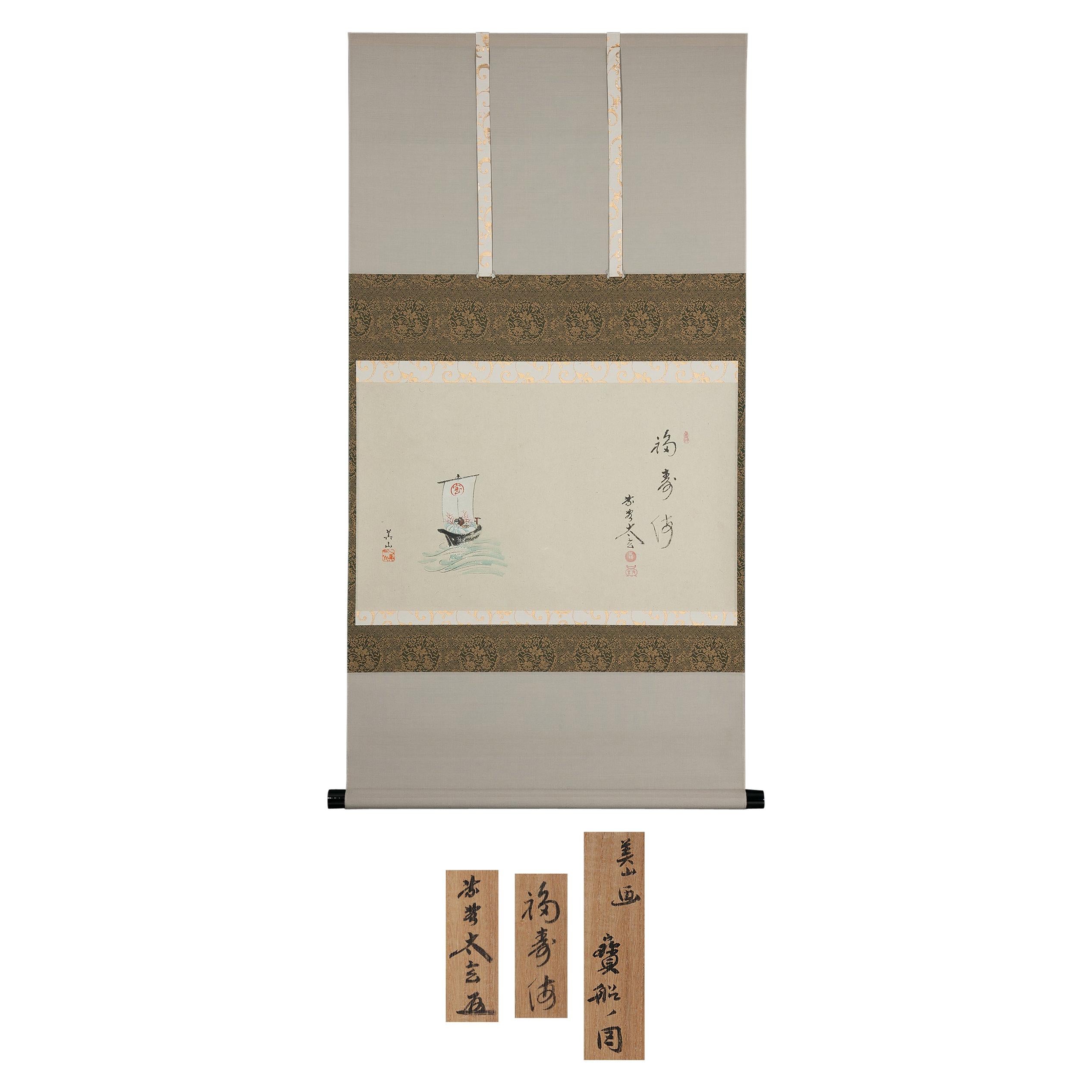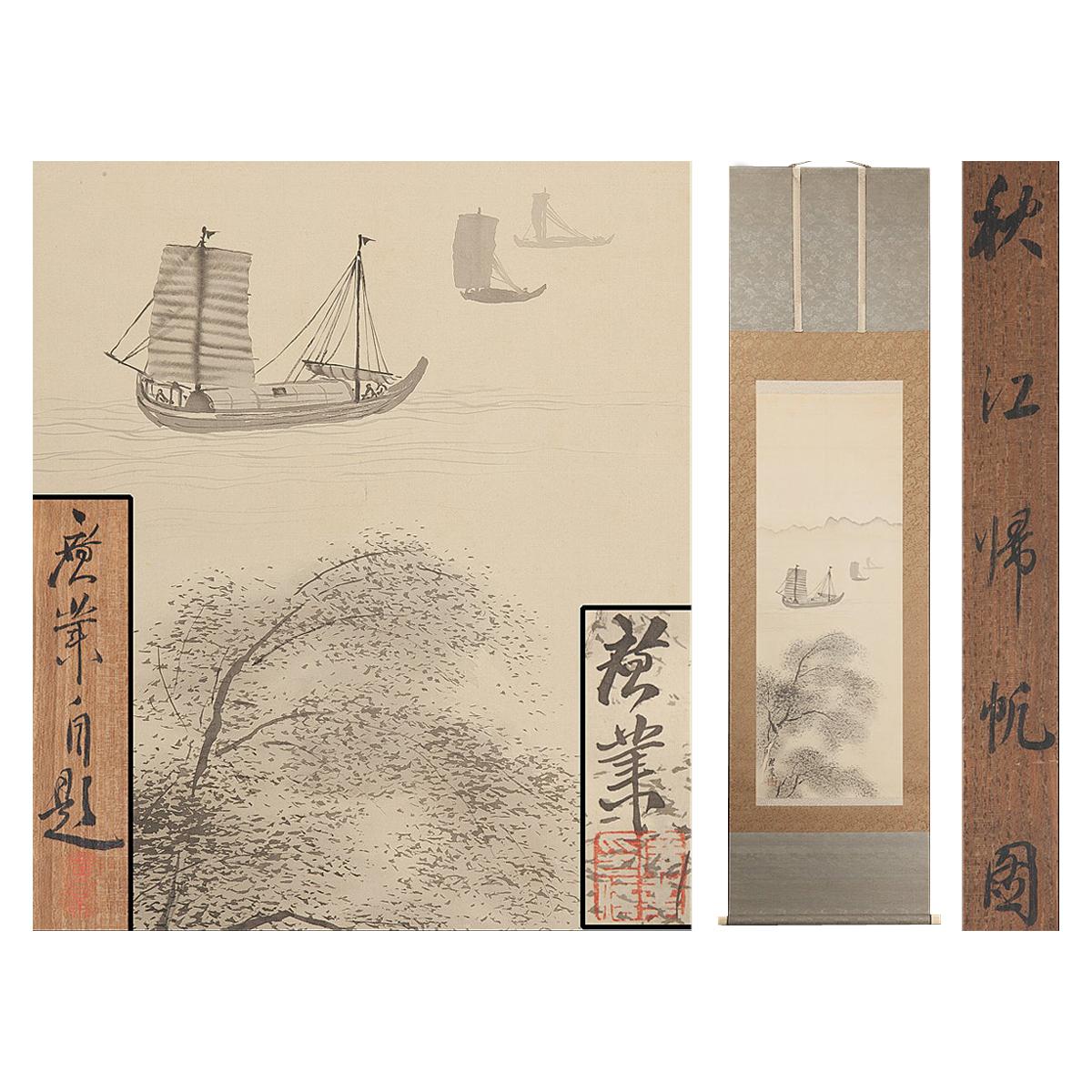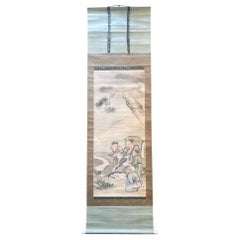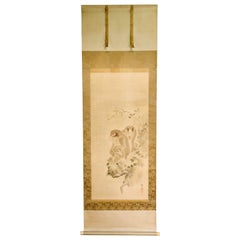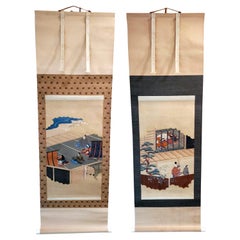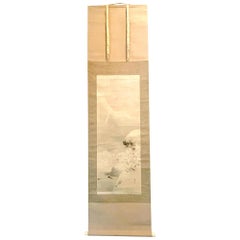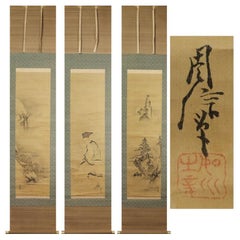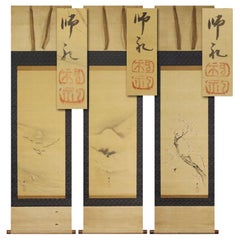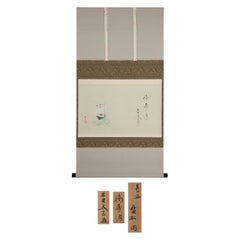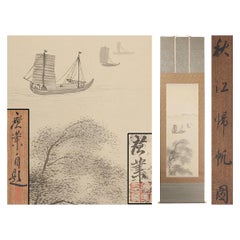Items Similar to Rare Triptych Scroll Paintings by Watanabe Seitei Meiji Period
Want more images or videos?
Request additional images or videos from the seller
1 of 21
Rare Triptych Scroll Paintings by Watanabe Seitei Meiji Period
$12,000
£9,110.20
€10,420.12
CA$16,765.74
A$18,647.16
CHF 9,736.97
MX$226,916.14
NOK 124,355.95
SEK 116,623.94
DKK 77,769.35
Shipping
Retrieving quote...The 1stDibs Promise:
Authenticity Guarantee,
Money-Back Guarantee,
24-Hour Cancellation
About the Item
A set of three paintings of ink and watercolor on silk mounted within brocade borders as scrolls by Watanabe Seitei (1851-1918). This is a very rare and well preserved triptych by the artist, signed and dated to the year of 1902, Meiji 35th year. They were likely created for a specific client with a hanging location in mind as each piece was marked left, middle or right as a prearrangement. The middle scroll depicts a samurai in his full armor holding a staff on horseback marching with his two foot soldiers in a mountainous landscape. The left and right scrolls were extensions of the landscape done in his classic Nihonga (New Japanese style) influenced not only by Chinese classic ink wash painting but also a western dimensional, minimalistic and almost impressionist style. Although the landscape is not a physical continuation of the middle part, it conveys a sense of time and place where the traveling trespassed. The left is clearly a summer day with swallows flying in the breeze above a pond dotted with lotus. The mist rises to blur the visage of the hills afar. The right side is a nightly scene under a crescent moon. At the edge of the water, a thatched pavilion perched lonely among the trees Again the ink wash created a dreamy misty effect, suggesting perhaps the unknown nature of the journey. All three scrolls were signed and sealed "Seitei" with the middle one dated to 1902 Spring Summer in Kanji. It appears that the triptych has always been kept as a set in the persimmon wood box with a kiri wood interior holder custom-made for them. Under the cover of the lid, there is a red seal as well as a paper label with a collector's seal on it. However, it is hard to decipher the archaic form completely but it appears to be "Nine Layer Gao Residence collection". When hanging, the measurement is 22' x 82". The measurement posted is the size of the storage wood box.
Watanabe Seitei, also known as Watanabe Shotei (1851–1918), was born in late Edo period. He was one of the earliest Japanese artists who visited and became well-known in the West. In 1878, he travelled to France and attended International Exhibition in Paris and stayed for three years. Due to his exposure to the art in the west, his work, known as Nihonga (Japanese-style), blended a sense of Western realism with Japanese approach to aesthetics by using ink wash and delicate colors. He is also well known for the designs he created for cloisonné artist Namikawa Sosuke (1847–1910), whose work became quite famous and collectible in the west at the beginning of the 20th century. His artistic style had an important and long impact on the later Nihonga painters.
- Dimensions:Height: 4.75 in (12.07 cm)Width: 26.75 in (67.95 cm)Depth: 9 in (22.86 cm)
- Style:Japonisme (Of the Period)
- Materials and Techniques:
- Place of Origin:
- Period:1900-1909
- Date of Manufacture:1902
- Condition:Wear consistent with age and use. The scrolls are in fine antique condition with expected creases on silk. The middle scroll shows minor foxing in area. The storage box shows some wear.
- Seller Location:Atlanta, GA
- Reference Number:1stDibs: LU945023400232
About the Seller
4.9
Platinum Seller
Premium sellers with a 4.7+ rating and 24-hour response times
Established in 2006
1stDibs seller since 2010
564 sales on 1stDibs
Typical response time: <1 hour
- ShippingRetrieving quote...Shipping from: Atlanta, GA
- Return Policy
Authenticity Guarantee
In the unlikely event there’s an issue with an item’s authenticity, contact us within 1 year for a full refund. DetailsMoney-Back Guarantee
If your item is not as described, is damaged in transit, or does not arrive, contact us within 7 days for a full refund. Details24-Hour Cancellation
You have a 24-hour grace period in which to reconsider your purchase, with no questions asked.Vetted Professional Sellers
Our world-class sellers must adhere to strict standards for service and quality, maintaining the integrity of our listings.Price-Match Guarantee
If you find that a seller listed the same item for a lower price elsewhere, we’ll match it.Trusted Global Delivery
Our best-in-class carrier network provides specialized shipping options worldwide, including custom delivery.More From This Seller
View AllJapanese Silk Scroll by Haruki Nanmei Edo Period
Located in Atlanta, GA
A Japanese hanging silk scroll by late Edo period painter Haruki Nanmei (1795-1878). The gouache painting was in the tradition of Kano school and depicts an old scholar dressed in lo...
Category
Antique 19th Century Japanese Edo Paintings and Screens
Materials
Silk, Paper
Japanese Silk Scroll Painting of Moneys Edo Period Mori Tetsuzan
Located in Atlanta, GA
A Japanese mounted vertical hanging scroll painting by Mori Tetsuzan (Japanese, 1775-1841) circa 19th century Edo period. The watercolor and ink on silk ...
Category
Antique 19th Century Japanese Japonisme Paintings and Screens
Materials
Silk, Paper
Two Antique Japanese Hanging Scroll Paintings
Located in Atlanta, GA
Two Japanese scroll painting depicts scenes from the Tale of Genji (Genji-E), from Edo period. These painting were purchased from Odewara Shoten in the...
Category
Antique Early 19th Century Japanese Japonisme Paintings and Screens
Materials
Brocade, Paper
$4,800 / set
Japanese Ink and Wash Scroll Painting by Watanabe Seitei
Located in Atlanta, GA
Watanabe Seitei, also known as Watanabe Shotei (1851–1918), was born in late Edo period. He was one of the earliest Japanese artists who visited and be...
Category
Antique Early 1900s Japanese Japonisme Paintings and Screens
Materials
Brocade, Silk, Paper
Antique Japanese Hanging Scroll Attributed to Iwasa Matabei
Located in Atlanta, GA
An antique ink and color on paper hanging scroll (kakejiku) with brocade border. It appears to be a fragment of a larger hand scroll depicting a procession of a lord with his entoura...
Category
Antique Early 17th Century Japanese Japonisme Paintings and Screens
Materials
Silk, Paper
Collection of Five Japanese Oshi-E Textile Art Panels Meiji Period
Located in Atlanta, GA
On offer is a set of five Japanese textile art panels called Oshi-E circa Meiji Period (1868-1912). This usual set of panels depict various aspects of daily life in Edo time with beautiful details. Some of these panels are snapshots of the buzzling commercial activities at the marketplace, providing insight into the signages, architecture, costumes and how people interacted within a historical and pictorial context. Other panels depict daily leisure activities such as lounging in the park or visiting friends. The realistic rendering and attention to details are not short of "photographic" quality. From the signage of the shops to the motions and attires of the individual characters, from the hairstyle, small ornaments, down to the facial expression, were all recorded in great details. Each panel was signed with the artist's name Yukihana in Kanji with a red seal.
These panels are unframed and await your custom touch (framing with inner gilt spacer and mat costs about 250-500 depending on the material chosen, see a framed example in the last picture of a single framed panel we have for sale). We offer them for sale individually, but it will be great for a collector to consider the whole set so that they can stay together.
The Oshi-E (also known as kiritori zaiku) is a type of ornamental textile art dated back to the Muromachi period (1392-1573). It started among the elite aristocratic women in Kyoto before spreading wider in the Japanese society. Throughout Edo and Meiji period, Oshi-E were sometimes used to make offerings to the altars in the temple and in the late 19th century, it was exported to the west along with the other embroidery textile art. Oshi-E was made by using silk wadding to create a relief design. Various silk fabric swaps and sometimes wires and tassels, often recycled from older kimonos...
Category
Antique 1890s Japanese Japonisme Textiles
Materials
Silk, Giltwood
You May Also Like
Japanese Painting 17th c Edo Scroll Triptyque Kano Chikanobu Buddhist Painting
Located in Amsterdam, Noord Holland
TheItem below was painted approximately 300 years ago by Kano Chikanobu. In the center is a depiction of a deer hermit, on the right is a landscape of a tower that gives a sense of ...
Category
Antique 17th Century Edo Paintings
Materials
Silk
$3,448 Sale Price
20% Off
Lovely Japanese 18/19th c Edo Scroll Triptyque , Fuji, Dragon Flowers
Located in Amsterdam, Noord Holland
This is a pair of Edo period pieces, each with a beautiful ``cherry blossoms and swallow'', ``Fuji and rising dragon'', and ``wild geese'' .
■Silk book, handpainted
■Condition:
T...
Category
Antique 18th Century Edo Paintings
Materials
Silk
$1,723 Sale Price
20% Off
Lovely 20th Century Scroll Paintings Japan Tomobako Showa Artist Kobayashi
Located in Amsterdam, Noord Holland
Great decorated piece, artist Kobayashi Futoshi Gensho (B.1938-now)
Condition:
Very good. Size: Axis, vertical 117 cm horizontal 60.5 cm, painting, vertical 35 cm horizontal 58.5...
Category
20th Century Japanese Showa Paintings and Screens
Materials
Fabric
$1,213 Sale Price
25% Off
Scroll Painting Japanese 19th-20th Century Kōgyō Terasaki Meiji
Located in Amsterdam, Noord Holland
A fabulous landscape by Kogyo Terasaki
1866-1919
Japan painter. Akita prefecture production. Character is Tokusato, Soyama-Agaryunoki, beautiful poetry Yamabito, etc. to another is...
Category
20th Century Japanese Meiji Paintings and Screens
Materials
Bronze
$1,258 Sale Price
25% Off
Lovely 19th-20th Century Scroll Painting Japan Artist Kawagoi Tamado Painted
Located in Amsterdam, Noord Holland
It is a high-quality craft of the work drawn by Kawai Yudou as you can see.
The slightly hazy distant mountains are really tasty,
and the pine tree drawn in the foreground is a very tasty work.
«Kawagoedado»
[1873-1957] Japanese painter. Born in Aichi.
His real name is Hosaburo. Another issue, Ikuan.
At the beginning, he studied under the Shijo school and then Masakuni Hashimoto to...
Category
Early 20th Century Japanese Meiji Paintings and Screens
Materials
Silk
$2,060 Sale Price
20% Off
Lovely 17th-18th Century Scroll Painting Japan Artist Kano Soyu Painted
Located in Amsterdam, Noord Holland
It is a work that is said to have been drawn by Kano Soyu as you can see.
It is a picture of the light-colored Sansui map carefully drawn to the smallest detail, and the
towering m...
Category
Antique 17th Century Japanese Edo Paintings and Screens
Materials
Silk
$3,019 Sale Price
20% Off
More Ways To Browse
Scroll Painting
Ink Scroll
Asian Silk Paintings Antique
Meiji Scroll
Chinese Scroll Paintings
Scroll Painting Silk
Meiji Silk
Red Chinese Screen
Antique Triptych
Chinese Brocade
French Silk Brocade
Antique Ink Well Set
Chinese Silk Brocade
French Painting Silk
Japanese Scrolls
Edo Scroll
Chinese Silk Scroll
Chinese Ink On Silk
